The HP Z8 Fury G5 is a monstrously powerful desktop workstation with a 56-core Intel “Sapphire Rapids” Xeon CPU and four 300-watt graphics cards. There’s no task it can’t handle.
HP Z8 Fury G5 Specifications
The HP Z8 Fury G5 is HP’s premiere desktop workstation, supporting a single Intel Xeon W-class “Sapphire Rapids” processor with up to 56 cores and 2TB of DDR5-4800 ECC memory. Its hallmark feature is supporting four 300-watt double-wide graphics cards. As you’ll see shortly, our unit has the ultimate setup, with four NVIDIA RTX A6000 GPUs. A 2,250-watt power supply (actually two 1,125-watt units) powers the entire setup. This is an unprecedented amount of processing (and electrical) power.
HP is also offering a non-Fury Z8 G5 with two 32-core Xeon CPUs and 1TB of RAM, but it warned us that this is the last time we’ll see dual-CPU workstations. On the Intel side of things, expect dual CPU setups to be reserved for servers only going forward.
You can rightfully expect a workstation of this caliber to be highly configurable. Multi-GPU setups are the Z8 Fury G5’s forte, but HP also advertises up to 120TB of internal storage, so it doesn’t have to be fully GPU-focused. Having four GPUs, like our unit, limits configurability somewhat, as we’ll discuss. For now, here are the Z8 Fury G5’s basic specifications.
| Operating Systems |
|
| Processor | Intel Xeon W-Class “Sapphire Rapids” up to 56 cores/350 watts base power |
| Chipset | Intel W790 |
| Memory | Up to 2TB DDR5-4800 ECC (16 DIMM) |
| Drive Bays |
|
| Graphics | Up to four 300-watt double-wide GPUs, AMD/Intel/NVIDIA |
| Expansion Slots | 1 PCIe 3 x8; 2 PCIe 5 x16; 1 PCIe 5 x4; 2 PCIe 4 x16; 2 PCIe 4 x4; 2 PCIe 4 x8 (Rear bulkhead access can be achieved through all slots but 2 PCIe 4 x8, and 2 PCIe 4 x8 are internal access only for M.2 (1 PCIe 4 x16 available when 2nd CPU is not installed; 1 PCIe 3 x16 available only when 2nd CPU is installed).) |
| Communication and Communication Options |
|
| Security Management |
|
| Power Supply Options |
|
| Dimensions | 8.5 x 21.7 x 17.5 inches |
| Sustainable Impact Specifications |
|
HP Z8 Fury G5 Build and Design
The Z8 Fury G5 is an enormous tower at 8.5 x 21.7 x 17.5 inches. Its industrial looks are easy on the eyes and mean all business. Notice all the front-panel airflow perforations. (More on that important topic later.)
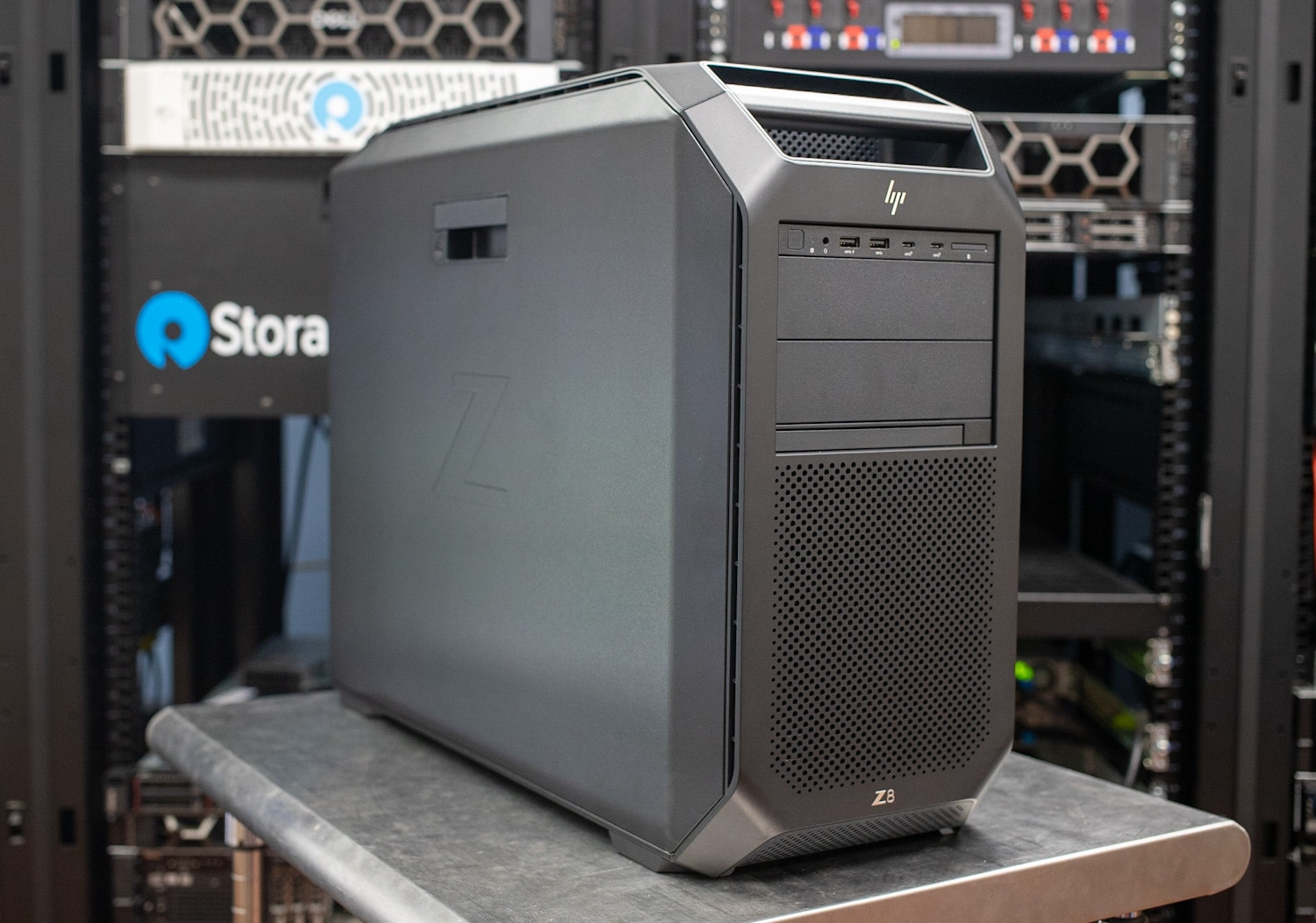
The Z8 Fury G5 is built to last; HP puts it through MIL-STD-810H testing, which it passed. The tower is nearly all metal and is rock solid.
The Z8 Fury G5 comes with a standard or premium front panel. Standard-panel ports include 4x USB-A 3.2 Gen 1 (5Gbps), while the premium panel on our unit has 2x USB-A 3.2 Gen 1 and 2x USB-C Gen 2×2 (20Gbps). Both panels have a headset jack. A media card reader is optional.
Our review unit doesn’t have the optional four-bay hot-swap front M.2 drive unit, which is slated for availability later in 2023. It would be an excellent option for quickly transferring data, which is critical considering how much data this system can process. For the next generation, we’d be interested in seeing HP utilize enterprise storage formats, such as E.3S, allowing for much greater capacities and increased durability.
Security is paramount on a high-end workstation like this. The Z8 Fury G5’s physical security features include lockable front access carriers, side panel locks with an interlock sensor, and a Kensington lock slot. The Z8 Fury G5 can also be rack-mounted.
The motherboard’s backplane comes standard with two Gigabit Ethernet ports, with two 10GbE ports available as an option. Faster wired networking than that would require using a PCIe slot, which is a no-go if your system is configured with four GPUs like ours. Wi-Fi 6E and Bluetooth can also be added via PCIe. Other rear ports include 6x USB-A 3.2 Gen 1.
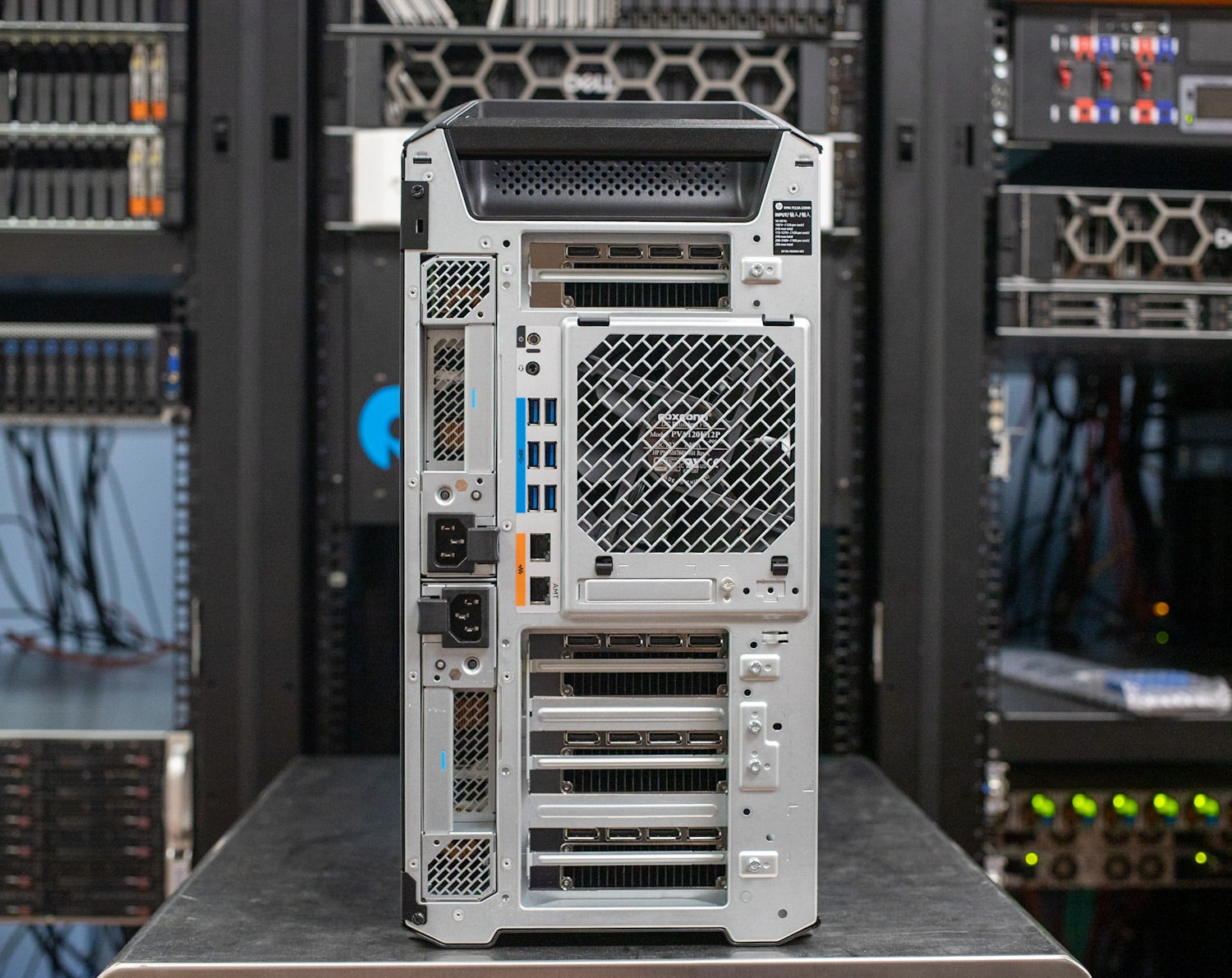
Our system’s 2,250 watts of power come from two aggregate 1,125-watt power supplies. They’re removable, server-style, as seen here. In Z8 Fury G5 configurations that can operate on a single 1,125-watt power supply, the second one can be used for redundancy.
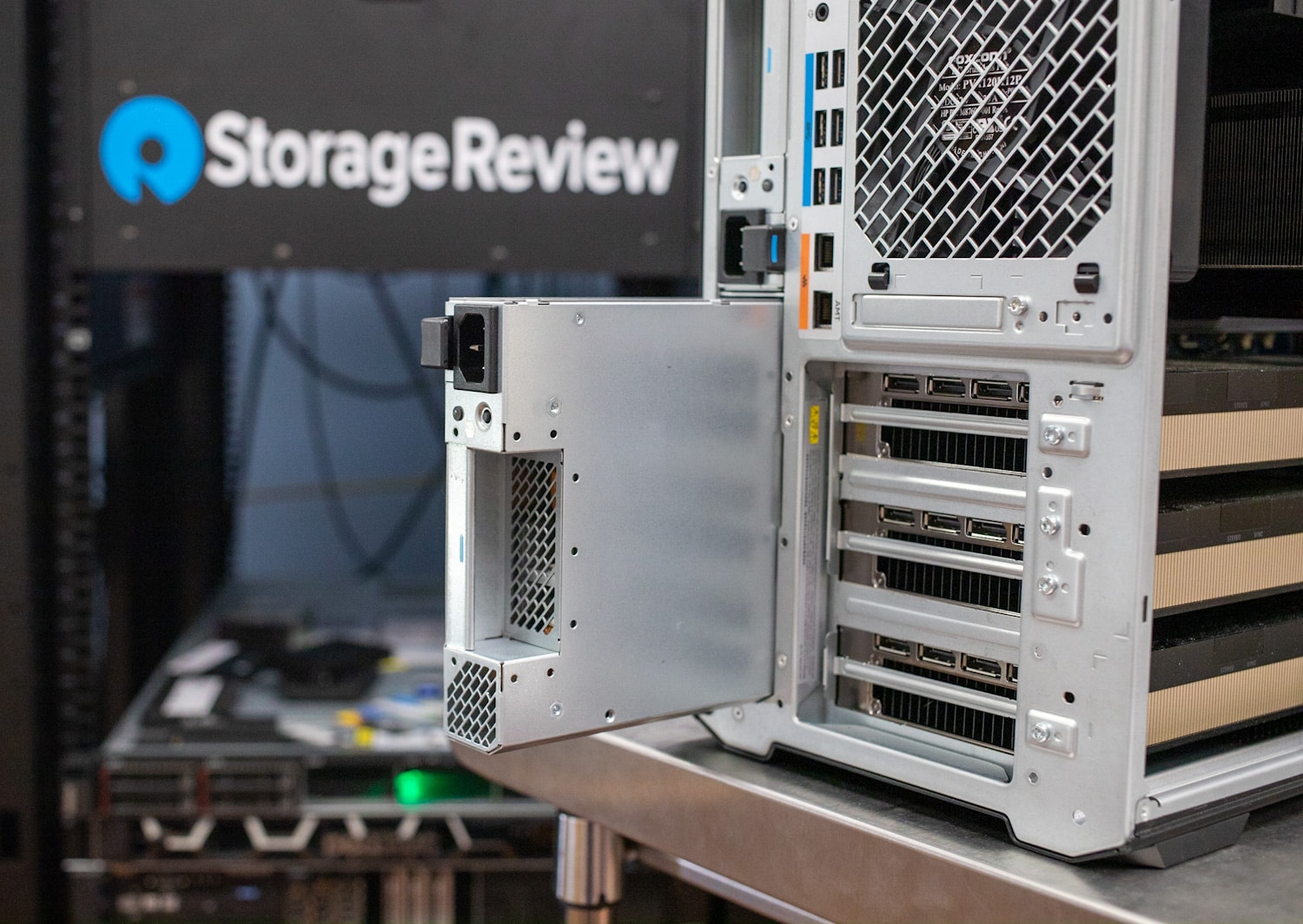
Both side panels come off for interior access.
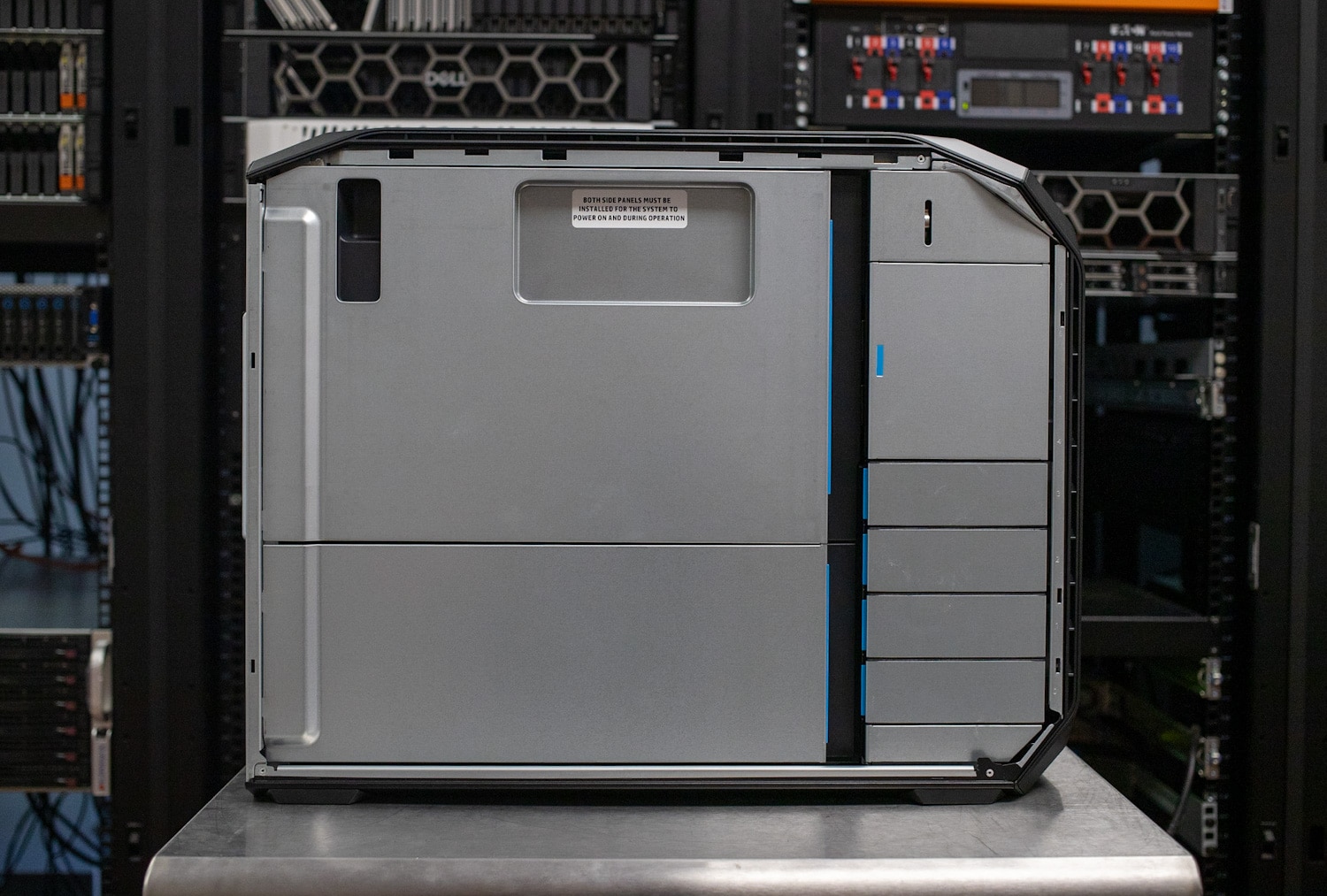
All the action is behind the left panel, where you’ll see this technological paradise.
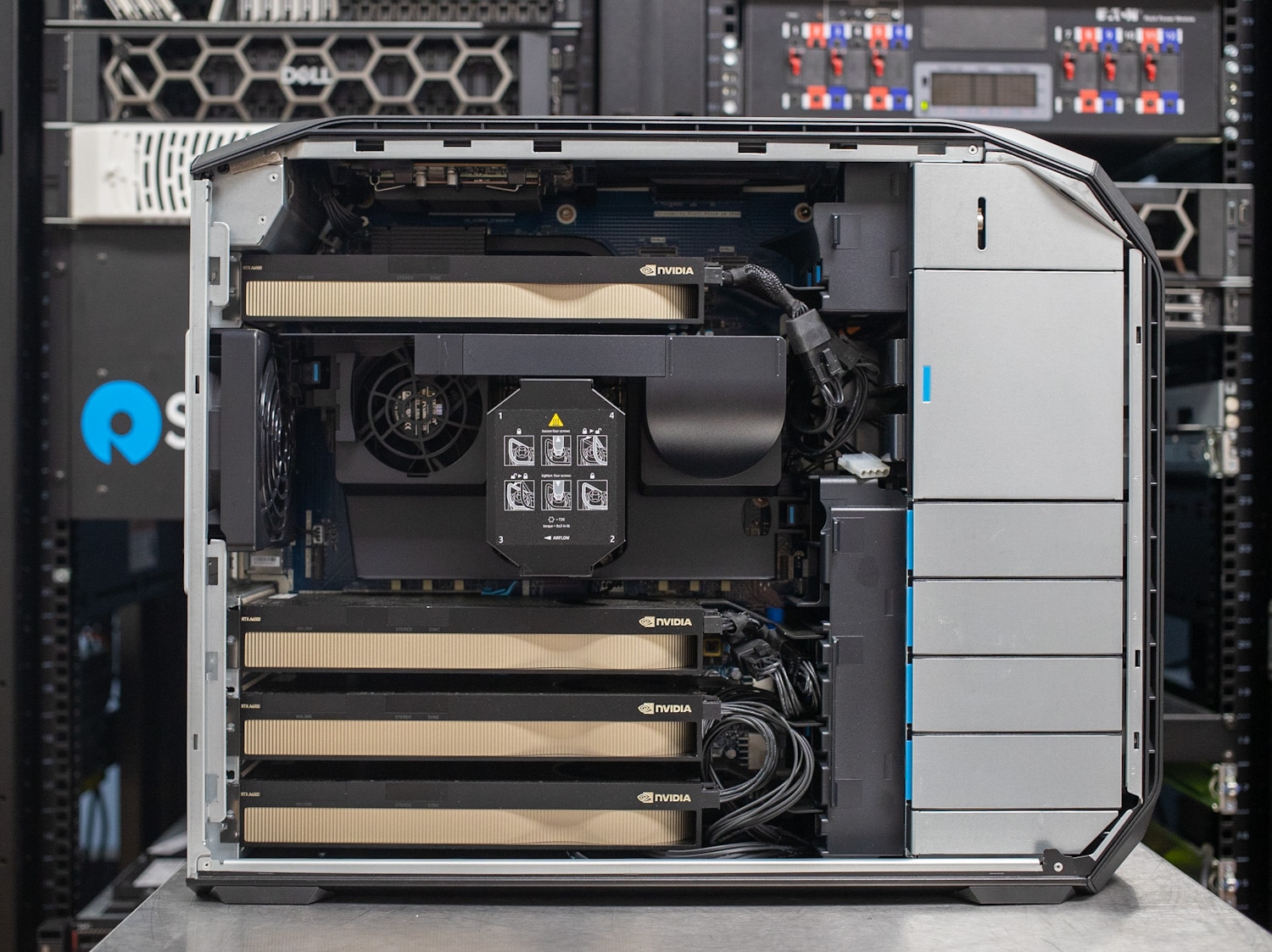
The four NVIDIA RTX A6000 GPUs are a formidable sight. The cards are double-wide but spaced a nonstandard 2.5 slots apart for improved airflow between the cards.
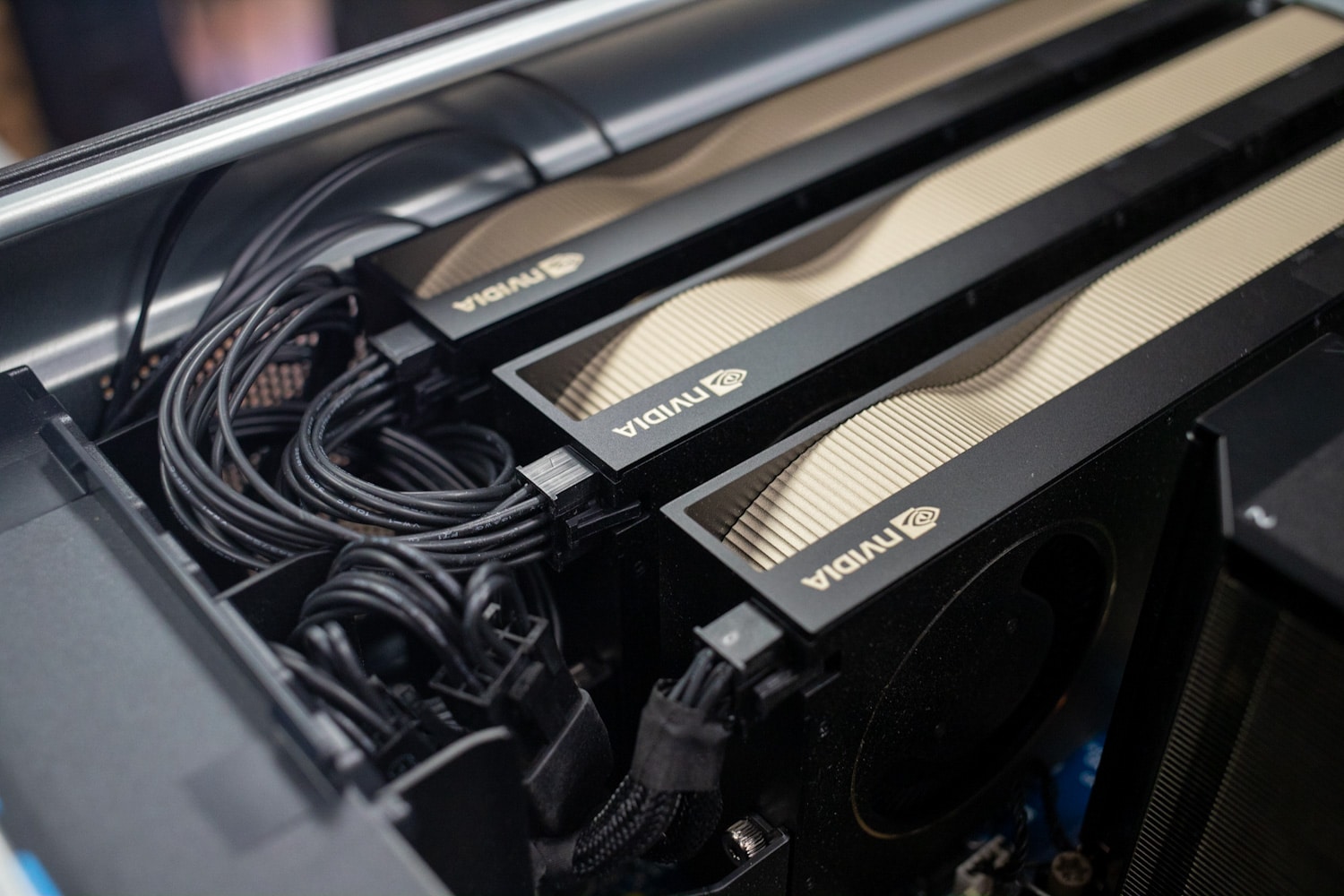
Airflow in this tower is front to back; HP “zoned” the chassis, so each GPU, CPU, and DIMM slots effectively have its own air channels.
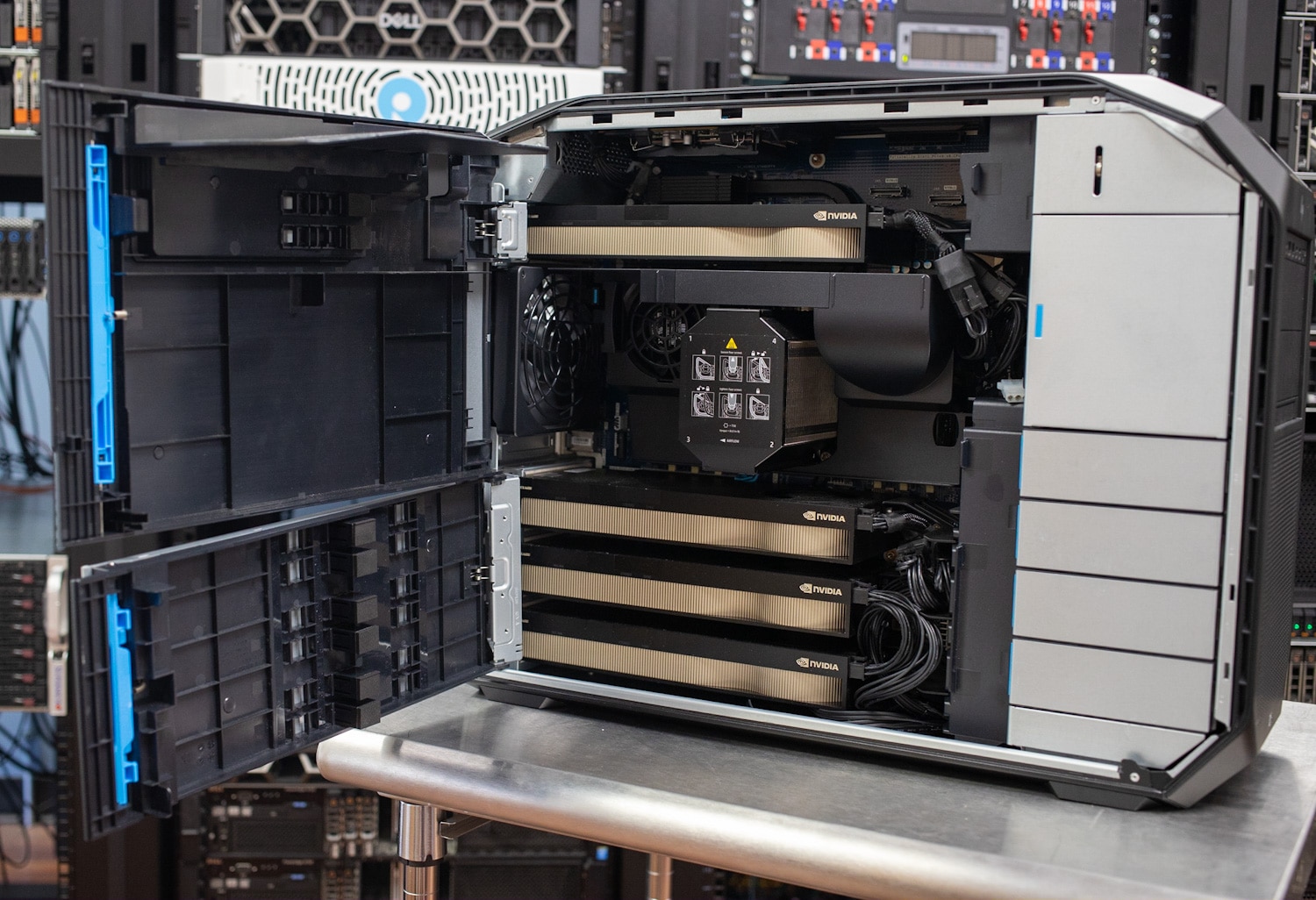
The massive CPU air cooler is responsible for a 350-watt CPU. The 56-core Xeon chip in our unit mandates the premium cooler, which has a vapor chamber and phase-change technology.
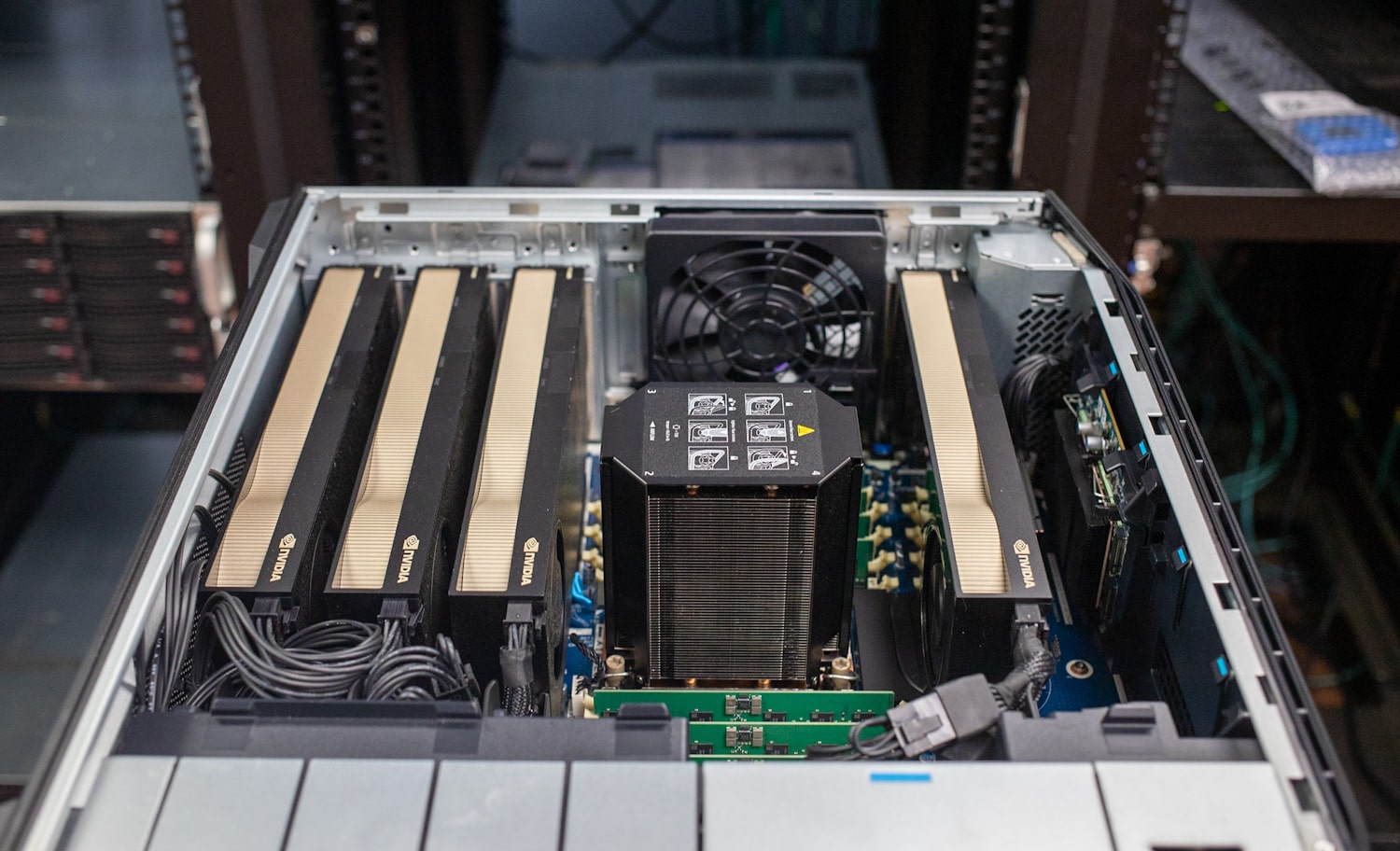
Sixteen DDR5-4800 ECC DIMM slots flank the CPU, each covered by a cooling shroud.
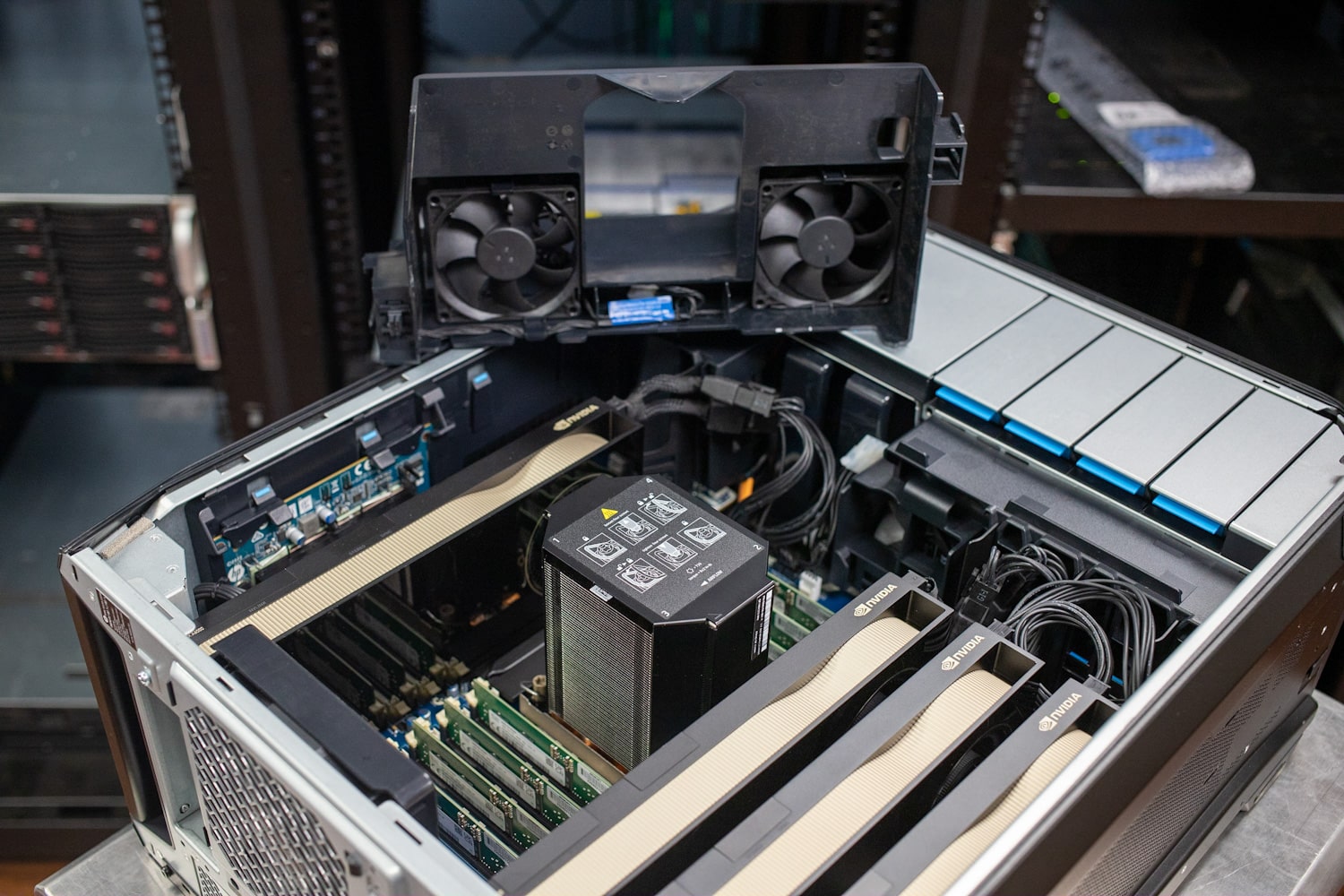
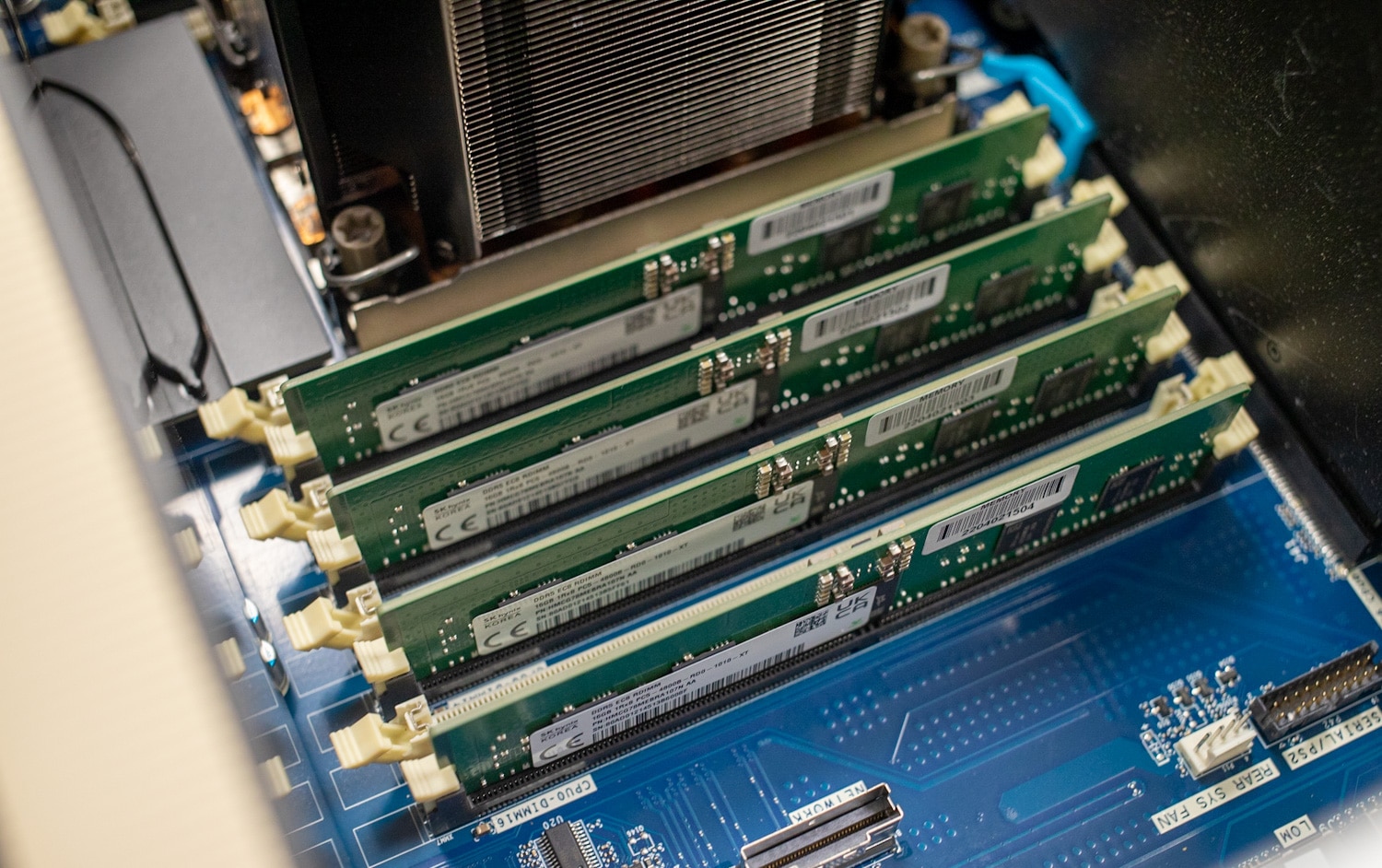
This tower has 20 sensors and 28 fan speed algorithms to maintain optimal temperatures. The fans can’t be manually controlled beyond cooling profiles in the BIOS. We could still control the GPU’s fans through NVIDIA drivers without going into the BIOS, which is important if you’re running the GPUs full-tilt and want them to maintain their boost clocks.
The Z8 Fury G5 has eight PCIe slots, though, with four double-wide GPUs like our unit, the others are blocked. The three PCIe slots closest to the processor (two immediately above and one below) are Gen5 to avoid the costs of re-drivers.
The motherboard has an integrated HP Anywhere Remote System Controller, which means you don’t sacrifice a PCIe slot for that connectivity. This system controller allows the Z8 Fury G5 to be operated remotely in a data center.
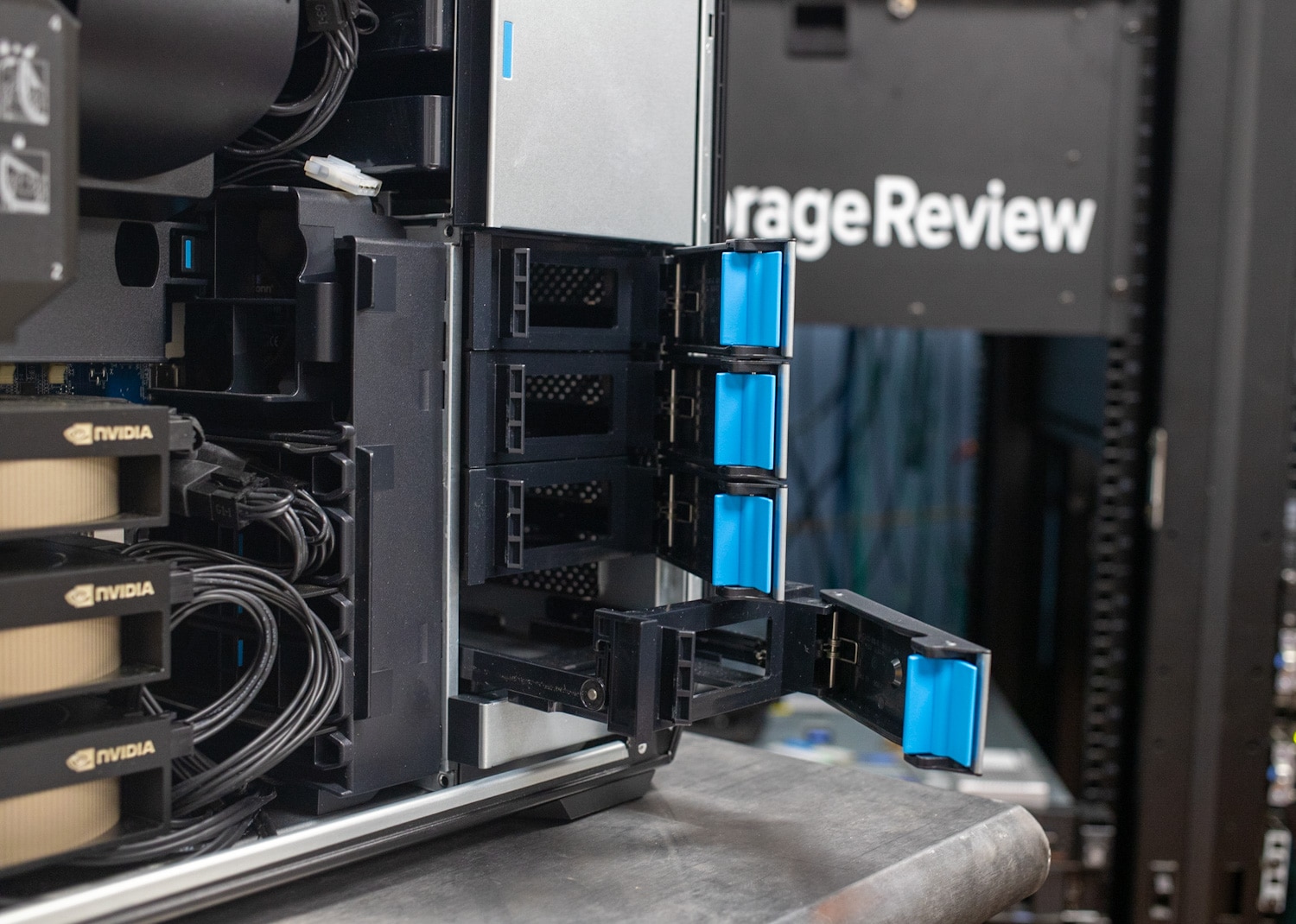
There are four toolless 3.5-inch expansion bays. HP also offers PCIe cards capable of holding multiple M.2 drives, though to fit them, you can’t have four GPUs. Still, it appears that HP used every inch of this interior for performance or expansion. It’s an impressive machine.
HP Z8 Fury G5 Performance
Our exceptional Z8 Fury G5 review unit has the following specifications:
- Windows 11 Pro
- Intel Xeon w9-3945X CPU (56 cores, 112 threads, 4.8GHz Turbo Boost, 350-watt base power)
- 4x NVIDIA RTX A6000 GPUs
- 128GB DDR5-4800 ECC RAM (16x 8GB, quad-channel)
- 2x 1TB Gen4 SSDs (non-RAID)
- 2250-watt power supply (2x 1,125-watt units)
The Z8 Fury G5 starts at about $5,500. We don’t have exact pricing for our unit, but considering each RTX A6000 graphics card adds about $6,000 (of which, again, we have four!) and the 56-core CPU nearly $10,000, expect it to be over $40,000. Enterprises buying these machines will likely be able to negotiate.
Testing the Z8 Fury G5’s four GPUs proved challenging. Many of our tests wouldn’t run, and several didn’t utilize all its GPUs.
We are comparing the Z8 Fury G5 to the following high-end workstations:
- Dell Precision 7865:
- AMD Threadripper Pro 5995WX (64 cores, 128 threads, 280-watt)
- NVIDIA RTX A6000
- 64GB DDR4-3200 ECC
- Lenovo ThinkStation P620:
- AMD Threadripper Pro 5995WX (64 cores, 128 threads, 280-watt)
- NVIDIA RTX A6000
- 1TB DDR4-3200 ECC
These workstations use AMD’s fastest workstation chip, so at least on the CPU side of things, they’ll make solid comparisons.
Blender OptiX
Blender is an open-source 3D modeling application. This benchmark was run using the Blender Benchmark utility. The score is samples per minute, with higher being better. This test only utilizes one graphics card, so the Z8 Fury G5 didn’t stand apart.
| Blender OptiX (Samples per minute, Higher is better) | |||
| Category | HP Z8 Fury G5 (Xeon w9-3945X, 4x RTX A6000) | Dell Precision 7865 (AMD 5995WX, RTX A6000) | Lenovo ThinkStation P620 (AMD 5995WX, RTX A6000) |
| Monster | 2,814 | 2,839 | 2,764 |
| Junkshop | 1,781 | 1,595 | 1,537 |
| Classroom | 1,519 | 1,384 | 1,369 |
Luxmark
Another 3D benchmark we will be looking at is LuxMark, an OpenCL GPU benchmarking utility. This test is multi-GPU friendly, and the Z8 Fury G5 took full advantage. Look at those numbers! They’re almost exactly four times the scores of the others.
| Luxmark (Higher is better) | |||
| HP Z8 Fury G5 (Xeon w9-3945X, 4x RTX A6000) | Dell Precision 7865 (AMD 5995WX, RTX A6000) | Lenovo ThinkStation P620 (AMD 5995WX, RTX A6000) | |
| Hallbench | 82,265 | 20,991 | 20,889 |
| Food | 31,242 | 7,866 | 7,643 |
V-Ray
This is a 3D rendering benchmark that supports multiple graphics cards. We only have results for the Z8 Fury G5; below are its results on one, two, and four GPUs.
| V-Ray | 1 RTX A6000 | 2x RTX A6000 | 4x RTX A6000 |
| RTX | 2,731 | 5,357 | 10,269 |
| CUDA | 1,853 | 3,779 | 7,491 |
Previously, we tested V-Ray on the NVIDIA GeForce RTX 3090 and the NVIDIA Quadro RTX 8000 graphics cards, so here are the single GPU comparisons to those cards. The RTX A6000 we’re testing is based on the consumer GeForce RTX 3090, though it has a different memory configuration. (There is a newer RTX A6000 that is identifiable with the “Ada Generation” suffix; we haven’t tested it yet.)
| V-Ray | HP Z8 Fury G5 (1x RTX A6000) | Quadro RTX 8000 | GeForce RTX 3090 |
| RTX | 2,731 | 1,1 | 2,606 |
| CUDA | 1,853 | 897 | 2,025 |
We also ran V-Ray’s CPU test, where the Z8 Fury G5 scored 46,165.
OctaneBench
Next, we look at OctaneBench, a benchmarking utility for OctaneRender, another 3D renderer with RTX support similar to V-Ray. The overall scores are shown, with higher numbers being better. The Z8 Fury G5 dominated with its quad GPUs, as expected.
| Scene | Kernel | HP Z8 Fury G5 (Xeon w9-3945X, 4x RTX A6000) | Dell Precision 7865 (AMD 5995WX, RTX A6000) | Lenovo ThinkStation P620 (AMD 5995WX, RTX A6000) |
| Interior | Info channels | 72.53 | 18.39 | 18.43 |
| Interior | Direct lighting | 264.18 | 66.64 | 66.55 |
| Interior | Path tracing | 343.06 | 86.40 | 86.27 |
| Idea | Info channels | 44.66 | 11.33 | 11.46 |
| Idea | Direct lighting | 207.55 | 52.14 | 52.28 |
| Idea | Path tracing | 255.55 | 64.19 | 64.46 |
| ATV | Info channels | 114.33 | 28.75 | 28.81 |
| ATV | Direct lighting | 296.01 | 74.09 | 73.97 |
| ATV | Path tracing | 371.35 | 93.20 | 93.07 |
| Box | Info channels | 61.14 | 15.60 | 15.55 |
| Box | Direct lighting | 262.21 | 66.25 | 66.32 |
| Box | Path tracing | 297.21 | 75.01 | 75.11 |
Blackmagic RAW Speed Test
We have also started running Blackmagic’s RAW speed test, which tests video playback. We only have results for the Z8 Fury G5 and the Precision 7865. The CPU numbers are similar, but the CUDA scores show how much power the HP’s quad RTX A6000s bring to the table.
| Blackmagic RAW Speed Test | HP Z8 Fury G5 (Xeon w9-3945X, 4x RTX A6000) | Dell Precision 7865 (AMD 5995WX, RTX A6000) |
| 8K CPU | 126 fps | 122 fps |
| 8K CUDA | 444 fps | 153 fps |
7-Zip Compression
The built-in memory benchmark in the popular 7-Zip archive tool responds well to faster memory with lower latencies. The Z8 Fury G5 seemed to lag behind the Precision 7865 here, though many variables in the memory configurations prevent an easy explanation. (We only started running this test recently, so we don’t have numbers for the ThinkStation P620.)
| 7-Zip Compression Benchmark | ||
| HP Z8 Fury G5 (Xeon w9-3945X, 4x RTX A6000) | Dell Precision 7865 (AMD 5995WX, RTX A6000) | |
| Compression | ||
| Current CPU Usage | 2523% | 3302% |
| Current Rating/Usage | 8.432 GIPS | 6.913 GIPS |
| Current Rating | 212.717 GIPS | 228.231 GIPS |
| Resulting CPU Usage | 2526% | 3293% |
| Resulting Rating/Usage | 8.370 GIPS | 6.973 GIPS |
| Resulting Rating | 211.422 GIPS | 229.630 GIPS |
| Decompressing | ||
| Current CPU Usage | 4628% | 6181% |
| Current Rating/Usage | 4.269 GIPS | 5.265 GIPS |
| Current Rating | 197.569 GIPS | 325.422 GIPS |
| Resulting CPU Usage | 4624% | 6188% |
| Resulting Rating/Usage | 4.226 GIPS | 5.265 GIPS |
| Resulting Rating | 195.389 GIPS | 325.813 GIPS |
| Total Rating | ||
| Total CPU Usage | 3575% | 4740% |
| Total Rating/Usage | 6.298 GIPS | 6.119 GIPS |
| Total Rating | 203.405 GIPS | 277.721 GIPS |
Geekbench 6
We ran a few extra benchmarks on the Z8 Fury G5 – after all, it’s not every day we get to test a system this well-equipped. Geekbench 6 is a cross-platform benchmark that measures overall system performance. We only have numbers for the Z8 Fury G5 in this test, but you can find comparisons to any system you want in the Geekbench Browser. Higher scores are better.
| Geekbench 6 | HP Z8 Fury G5 (Xeon w9-3945X, 4x RTX A6000) |
| CPU Benchmark – Single-Core | 2,179 |
| CPU Benchmark – Multi-Core | 18,515 |
| GPU Benchmark – OpenCL | 179,618 |
Cinebench R23
Maxon’s Cinebench R23 is a CPU rendering benchmark that utilizes all CPU cores and threads. We ran it for both multi- and single-core tests. This is another benchmark where we only have numbers for the Z8 Fury G5, but CPU reviews from major sites will have results from this test. Higher scores are better.
| Cinebench R23 | HP Z8 Fury G5 (Xeon w9-3945X) |
| CPU (Multi-Core) | 44,416 points |
| CPU (Single-Core) | 1,558 points |
| MP Ratio | 28.51x |
UL Procyon AI Inference
UL’s Procyon estimates a workstation’s performance for professional apps. We ran the AI Inference test for the CPU and then twice on the GPU, once using NVIDIA Tensor RT cores. We only have numbers for the Z8 Fury G5. Lower times are better, and higher overall scores are better.
| UL Procyon Average Inference Times | Xeon w9-3945X | RTX A6000 – GPU (Standard) | RTX A6000 – GPU (NVIDIA Tensor RT) |
| MobileNet V3 | 2.81 | 0.78 | 0.65 |
| ResNet 50 | 6.94 | 1.71 | 1.55 |
| Inception V4 | 29.59 | 3.89 | 4.73 |
| DeepLab V3 | 25.20 | 20.93 | 4.60 |
| YOLO V3 | 42.89 | 7.18 | 4.69 |
| REAL-ESRGAN | 1416.15 | 128.65 | 128.25 |
| Overall Score | 161 | 733 | 1027 |
GPUPI
What would be a quad-GPU system review without running GPU Pi? See our online result here – the Z8 Fury G5 scored 35 seconds, 126ms, with its quad RTX A6000 setup. Naturally, there aren’t many submissions for similar setups. Our rankings as of this writing are 15th out of 725 World Records, 2nd out of 22 Global Points for 4x GPU setups, and 1st of 1st among 4x RTX A6000s setups!
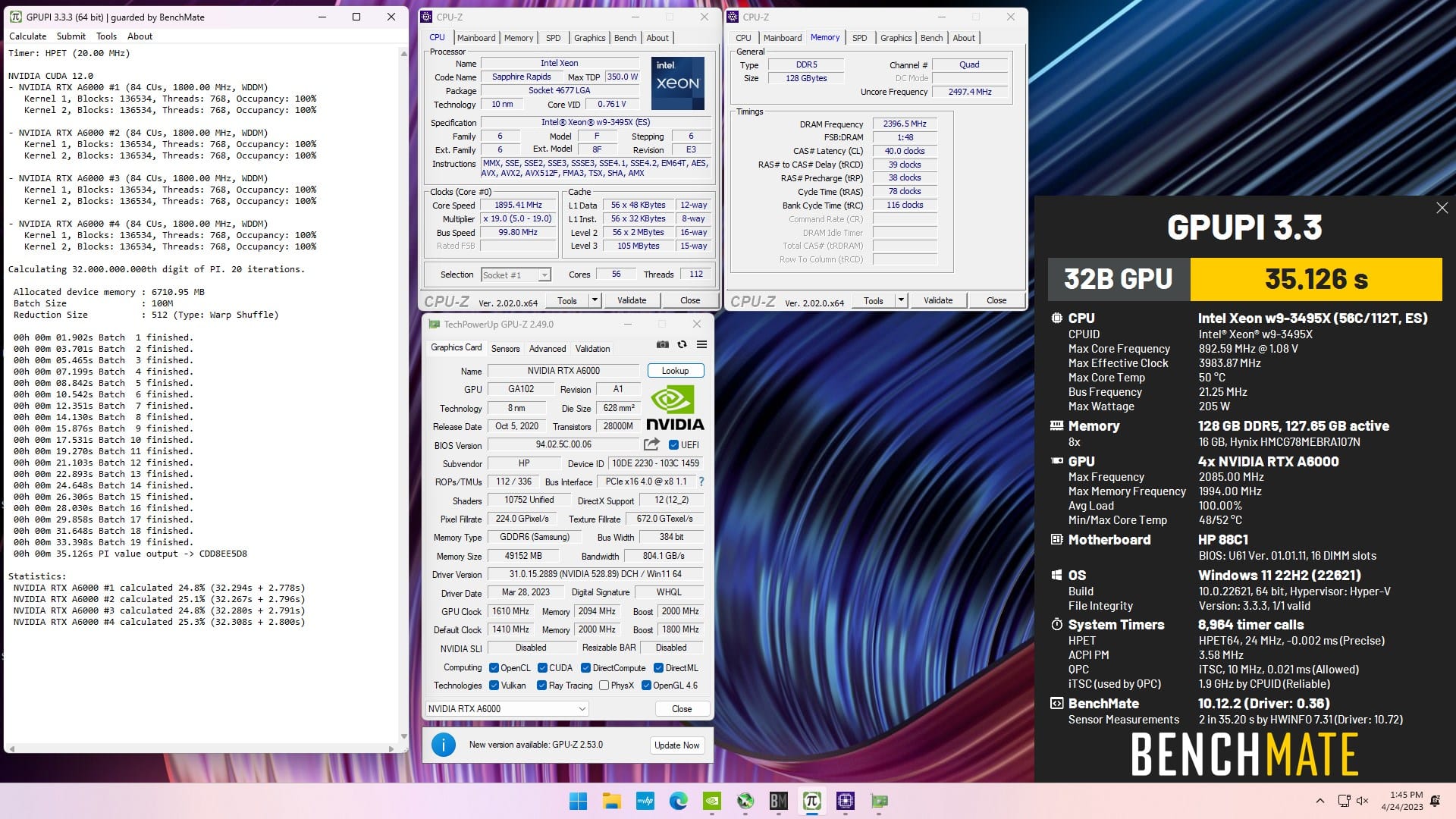
Conclusion
HP’s Z8 Fury G5 is an absolute monster, with up to a 56-core/112-thread CPU and four double-wide GPUs. Getting more computing power than this would mean stepping up to one or more rackmount servers. Configurability might be the Z8 Fury G5’s best asset; eight PCIe slots allow four GPUs or a combination of GPUs and expansion and/or storage cards. The 2TB memory ceiling is also excellent, as is PCIe Gen5 support on three PCIe slots.
Other features we appreciate about the Z8 Fury G5 are its excellent cooling, comprehensive security (hardware and software), and relatively quiet operation, given the power inside. We also like its built-in remote access controller. We look forward to seeing it become available with the front quad M.2 hot-swap bay.
And this review is just the start. Before we let HP pry this amazing system from our hands, we intend to make it our go-to for AI training and other data science workloads. These tasks are routinely vetted on a workstation before transitioning to a larger GPU training system, so the Z8 Fury G5 should absolutely dance like no one’s watching. Overall, we consider the Z8 Fury G5 the ultimate desktop workstation and award it our “Best of 2023” recommendation.





 Amazon
Amazon